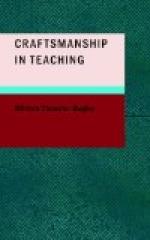I say this not to minimize in any way the importance that attaches to adolescent characteristics, but rather to suggest that you who are daily dealing with these pupils can in the aggregate add immeasurably to the knowledge that we now have concerning this period. A tremendous waste is constantly going on in that most precious of all our possible resources,—namely, human experience. How many problems that are well solved have to be solved again and again because the experience has not been crystallized in a well-tested fact or principle; how many experiences that might be well worth the effort that they cost are quite worthless because, in undergoing them, we have neglected some one or another of the rules that govern inexorably the validity of our inferences and conclusions. That is all that the scientific method means in the last analysis: it is a system of principles that enable us to make our experience worth while in meeting later situations. We all have the opportunity of contributing to the sum total of human knowledge, if only we know the rules of the game.
I said that one way of solving these subordinate problems that arise in the realization of our chief aims in teaching is the a priori method of applying general principles to the problems. Another method is to imitate the way in which we have seen some one else handle the situation. Now this may be the most effective way possible. In fact, if a sufficient number of generations of teachers keep on blindly plunging in and floundering about in solving their problems, the most effective methods will ultimately be evolved through what we call the process of trial and error. The teaching of the very oldest subjects in the curriculum is almost always the best and most effective teaching, for the very reason that the blundering process has at last resulted in an effective procedure. But the scientific method of solving problems has its very function in preventing the tremendous waste that this process involves. English literature is a comparatively recent addition to the secondary curriculum. Its possibilities of service are almost unlimited. Shall we wait for ten or fifteen generations of teachers to blunder out the most effective means of teaching it, or shall we avail ourselves of these simple principles which will enable us to concentrate this experience within one or two generations?
I should like to emphasize one further point. No one has greater respect than I have for what we term experience in teaching. But let me say that a great deal of what we may term “crude” experience—that is, experience that has not been refined by the application of scientific method—is most untrustworthy,—unless, indeed, it has been garnered and winnowed and sifted through the ages. Let me give you an example of some accepted dictums of educational experience that controlled investigations have shown to be untrustworthy.




